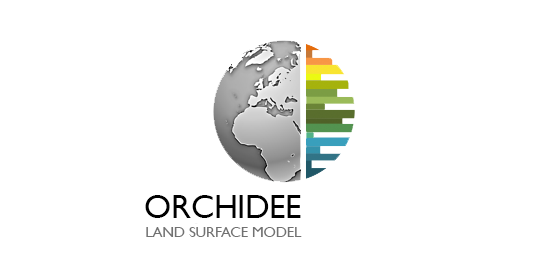| Version 21 (modified by klaurent, 6 weeks ago) (diff) |
|---|
Branch ORCHIDEE_3
Description
The branch ORCHIDEE_3 has been created in March 2020 @ r6611 from a copy of the trunk @ revision r6608. Based on ORCHIDEE_2, it gathers all the developments related to the Nitrogen cycle and the carbon/nitrogen interactions.
History
The development of the features contained in ORCHIDEE_3 started in 2013 in a branch named MERGE-OCN, a "merge" between the trunk version (source:/trunk@971) and the OCN model of Soenke Zaehle orchidee-N. In June 2005, the developments moved on the branch ORCHIDEE-CN, from an update revision of the trunk (source:trunk@2740). Developments, bug fixes and merges with the continuous evolution of the trunk have been done in branch orchidee-N up to December 2018. At date that, orchidee-N "moves" on the trunk of ORCHIDEE (source:/trunk@5639) to finalize more collectively this carbon-nitrogen version. The branch ORCHIDEE_3 has been created in March 2020 to continue finalizing the version ORCHIDEE_3 and to let the floor on the trunk of ORCHIDEE to the developments planned for version ORCHIDEE_4.
Publications and associated model revisions
Currently, two key model revisions of the "ORCHIDEE model with nitrogen" have been used in published studies. One is revision 4999 of branch ORCHIDEE (source:branches/ORCHIDEE-CN@4999) with which model evaluation in terms of GPP at local and global scale has been pusblished (see Vuichard et al., 2019 and https://doi.org/10.14768/20190724001.1). This version 4999 parcipated also to a model intercomparison study (NMIP) aiming at quantifying N2O emissions by land at global scale (see Tian et al., 2018; Tian et al., 2019 and Tian et al., 2020). The second major version is revision 6863 of the branch ORCHIDEE_3 (branches/ORCHIDEE_3@6863). This version participated to the GCB 2020 study published by Frielingstein et al., 2020 as the official ORCHIDEE model.
Model configurations and associated forcings
Standard configuration
The standard configuration of ORCHIDEE_3 accounts for a dynamic nitrogen cycle in which Nitrogen content in soil and plant reservoirs varies accordingly to environmental conditions. In this configuration, compared to Carbon-only model versions like ORCHIDEE_2, additional forcings are needed related to the different nitrogen inputs:
- Nitrogen atmospheric deposition: ORCHIDEE_3 considers seperately reduced (NHx) and oxydised (NOy) forms of nitrogen. By default, one uses the monthly atmospheric N deposition during 1860 - 2014 from the IGAC/SPARC Chemistry-Climate Model Initiative (CCMI) as in the Tian et al. (2019) and the current GCB papers. They are stored on the shared repositories here:
- ${R_IN}/SRF/NITROGEN/N_DEPOSITION/CCMI_ndep/historical/CCMI_ndep_nhx_${year}.nc
- ${R_IN}/SRF/NITROGEN/N_DEPOSITION/CCMI_ndep/historical/CCMI_ndep_noy_${year}.nc
- Synthetic fertilizer use: By default, one uses annual data from Lu and Tian, 2017 (https://doi.pangaea.de/10.1594/PANGAEA.863323) which provide the annual synthetic/mineral N fertilizer rate from 1960 to 2014 specifically for croplands and grasslands. They are stored on the shared repositories here:
- ${R_IN}/SRF/NITROGEN/N_FERTILISATION/NMIP/synthetic/historical/Nfer_pasture_${year}.nc
- ${R_IN}/SRF/NITROGEN/N_FERTILISATION/NMIP/synthetic/historical/Nfer_cropland_${year}.nc
- Organic fertilizer use: By default, one uses gridded annual manure N production in the period of 1860-2014 developed by Zhang et al., 2017 (https://doi.org/10.1594/PANGAEA.871980) and applied separately on grasslands and croplands. They are stored on the shared repositories here:
- ${R_IN}/SRF/NITROGEN/N_FERTILISATION/NMIP/manure/historical/Nmanure_pasture_${year}.nc
- ${R_IN}/SRF/NITROGEN/N_FERTILISATION/NMIP/manure/historical/Nmanure_cropland_${year}.nc
The use of manure in the model has to be done with caution as it added carbon in the ecosystem as well. This carbon is taken for the crop harvested biomass which is deduced from this term
- Biological nitrogen fixation: In ORCHIDEE-3, there is no computation of the BNF rate. One uses a single climatology for BNF as a function of present-day evapotranspiration following the approach of Cleveland et al. (1999). The forcing used by default is stored on the shared repositories here: ${R_IN}/SRF/NITROGEN/BNF/bnf_1850.nc
In addition to the Nitrogen-related forcings, the mineral nitrogen dynamic model needs soil pH and soil bulk density which are provided as model inputs. Default bulk density at 0.5×0.5 degree resolution is from the Harmonized World Soil Database (HWSD; FAO/IIASA/ISRIC/ISSCAS/JRC, 2012) and default soil pH from the International Geosphere–Biosphere Programme Data Information System (Global Soil Data Task Group, 2000). Datasets are stored on the shared repositories here: ${R_IN}/SRF/SOIL/soil_bulk_and_ph.nc
Non-interactive nitrogen configuration
An alternative configuration has been developped without carbon-nitrogen interactions, which can be used for studies/simulations not focusing on nitrogen impact or for control simulations and sensitiviy studies as it has been done in Vuichard et al., 2019. This configuration is the default setting for CL4 or CL5 simulations with ORCHIDEE_3 (see http://forge.ipsl.fr/igcmg/svn/CONFIG/UNIFORM/v6/LMDZOR_v6.3/). This configuration is activated when the flag IMPOSE_CN is set to true. In that case, the C/N ratio is fixed per PFT for all pixels. In combination to the flag IMPOSE_CN, if the flage STOMATE_READ_CN is set to true, the C/N ratio is read per PFT from 2D map. The default 2D map used in this case is stored under ${R_IN}/SRF/NITROGEN/CN_LEAF/cn_leaf_1850_v0.nc
